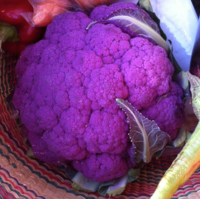
Photo from wikipedia
Despite current knowledge showing that fruits like tomato and grape berries accumulate different components of the light reactions and Calvin cycle, the role of green tissues in fruits is not… Click to show full abstract
Despite current knowledge showing that fruits like tomato and grape berries accumulate different components of the light reactions and Calvin cycle, the role of green tissues in fruits is not yet fully understood. In mature tomato fruits, chlorophylls are degraded and replaced by carotenoids through the conversion of chloroplasts in chromoplasts, while in red grape berries, chloroplasts persist at maturity and chlorophylls are masked by anthocyanins. To study isoprenoid and lipid metabolism in grape skin chloroplasts, metabolites of enriched organelle fractions were analyzed by high-performance liquid chromatography-high-resolution mass spectrometry (HPLC-HRMS) and the expression of key genes was evaluated by real-time polymerase chain reaction (PCR) in berry skins and leaves. Overall, the results indicated that chloroplasts of the grape berry skins, as with leaf chloroplasts, share conserved mechanisms of synthesis (and degradation) of important components of the photosynthetic machinery. Some of these components, such as chlorophylls and their precursors, and catabolites, carotenoids, quinones, and lipids have important roles in grape and wine sensory characteristics.
Journal Title: Journal of Agricultural and Food Chemistry
Year Published: 2023
Link to full text (if available)
Share on Social Media: Sign Up to like & get
recommendations!